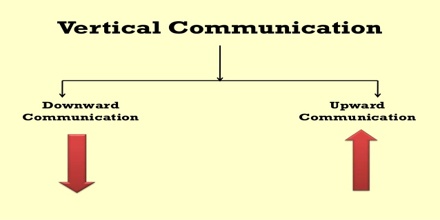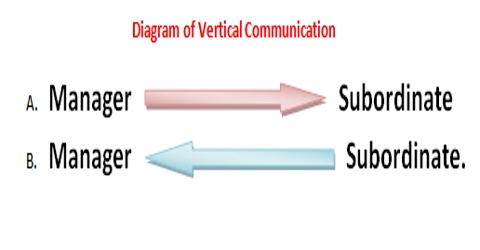Types of Vertical Communication
When information flows from superiors to subordinates or from subordinates to superiors, it is called vertical communication. In this type of communication, information moves wholly and from base to top. According to its nature, vertical communication is mainly classified into the following two types:
- Downward communication – When information moves all the system through or from superiors to subordinates, it actually is known as downward communication.
- Upward communication – In this type of communication information is transmitted backward: from lower to higher levels.

These two types of communication are explained below:
(1) Downward Communication:
Downward communication occurs when information flows from superior to subordinates. It occurs when information and messages flow down through an organization’s official chain of command or hierarchical formation. Superiors send information, orders, instructions, and decisions, etc., to their subordinates through downward communication. Downward communication can be of written or oral.
Main purposes of downward communication:
- To execute goals and strategies. Introducing new policies and ideas gives lower levels of information about favored actions.
- To endow with job instructions. Informing members and employees about necessities on their tasks.
- To give details procedures. Defining the organization’s base rules and regulations.
- To give a response. Evaluating the work of both individuals and groups.
This type of communication might form such as employees meetings, company newsletter, company strategy announcement, information memos, e-mail, face-to-face contact, orders, instruction, etc. Written forms of downward communication are manuals, handbook notices, electronic news displays, etc. whereas, face-to-face conversation, telephonic conversation, speeches, meetings, etc. are the oral media of downward communication. This communication is the most regularly used technique of transferring information in organizations.
(2) Upward Communication:
Upward communication takes place when information flows from subordinated to superior in the organizational hierarchy. This form of communication helps employees, to convey their views, thoughts or grievances with the top management. The purpose of upward communication is to provide information to the managers from subordinates. It is doable only in an autonomous environment, wherein employees have a say in management.
This communication is used in several situations such as:
- Making the chief conscious of the difficulties that staff members face.
- Stuff members suggesting improvements for the institution.
- Introducing reports concerning members’ results.
- Informing leaders about members’ complaints and grievances.
Generally, subordinates convoy their feelings, attitudes, opinions, suggestions, complains, etc. to their superiors through this communication. However, this system suffers from diverse limits like the long chain of command, lack of confidence in superiors, fear of appreciation, lack of common sharing, etc. Upward communication initiated at the lower level of the organization and reaches the message to the top management hierarchy.
















